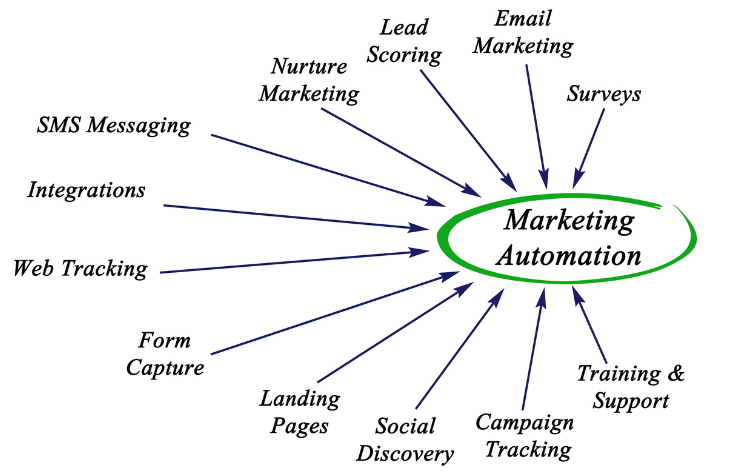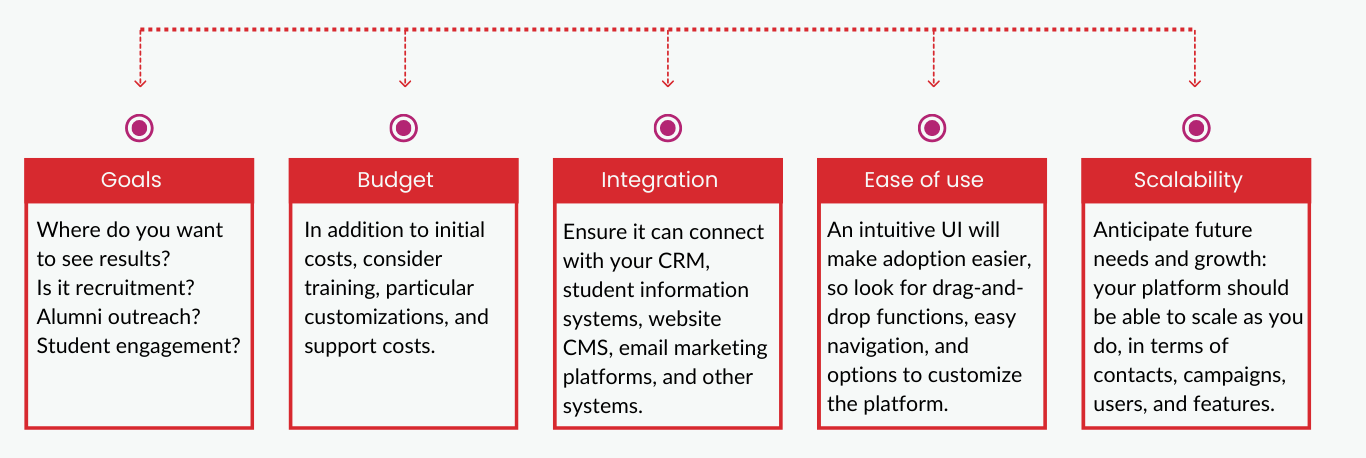Every prospective student deserves a personalized experience—and Gen Z expects it.
Marketing automation is one way you can connect the dots between your higher education digital channels and amplify their effectiveness.
Marketing automation tools can help make repetitive tasks faster and streamline workflows, making the recruitment journey more seamless (and personalized) for prospective students—at scale.
With stretched-out marketing teams and a digital landscape that’s constantly changing, marketing automation is a game changer.
And there are lots of ways to do it.
This week, we’re looking at how you can use marketing automation tools effectively for your university or college.

Getting started with marketing automation
Marketing automation can help your team streamline processes and make it more efficient, yes; but ultimately the goal is to improve engagement and recruitment growth.
A lot of email communications, social media posting, and lead nurturing can be automated, freeing up more time to focus on other initiatives and tasks and prioritize high-potential student prospects.
It’s a must for scaling your communications consistently without sacrificing this personal attention.
But the biggest benefits are in how marketing automation can help you score and segment leads, so you can tailor communications to prospective students’ interests and where they’re at in the enrollment journey.
Avoiding the pitfalls
Before leveraging some of these tools, make sure you understand your audience demographics, preferences, and behaviors, that you can map our the student journey through all the touchpoints, and that you have the resources to create personalized content for each part of that journey.
Automation can make life easier, but over-reliance can also lead to issues.
- That brand voice that you’ve worked so hard for can easily be diluted if your content becomes too impersonal.
- Your marketing automation will only be as strong as your content, especially if you’re using it for personalization, and this can take time and resources.
- If your marketing automation tools aren’t capturing student data correctly, you may be making the wrong assumptions about their preferences or interests—which can be detrimental to their user experience.
- Using the wrong tools or setting them up the wrong way can impact your marketing team, with increased costs and decreased trust, so it’s important to find the right tools that your team can make the most of.
You’ll need to allocate some resources and time also to analyze the performance of your automated campaigns and refine them to get the best results.
This is a test-and-iterate scenario, as so much of marketing is.
Lastly, we recommend ensuring that your university systems, like your CRM, website CMS, student information systems, and more can be integrated into the automation platform, so you can better manage your leads and communications.
Choosing the right platform

Choosing the right marketing automation platform is key to getting the results you want, and these will be based on your school’s goals and objectives.
Which platform is right for you?
Here’s what to consider:

What ways can you use automation?
Marketing automation can be used in several ways. For example:
- Personalized or behavior-based communications: Automatically show students other related courses or programs based on their interest.
Letting prospective students know you understand their interest in your school, whether it’s related courses, academic programs, campus life, financial aid, or anything else and delivering information on that topic will go a long way towards conversion.
This is also a great option for staying in touch with your alumni, with newsletters, event invitations, and updates on campus initiatives, or alumni achievements. - Lead generation: Place lead capture forms throughout your website to collect information from prospective students with their interests, email, intended program. Sync these to your CRM so you can segment the leads and personalize the comm
- A/B and multi-variant testing: Test different types of content with students and improve the performance of your landing pages, ads, and emails.
- Automated email campaigns: Set up campaigns to nurture leads and encourage engagement that are sent when triggered by specific actions or events on your school site, like a student filling out a form, registering for a campus tour, or downloading a course calendar.
- Personalized landing pages: Sync up campaigns with personalized landing pages tailored for specific audiences.
- Event reminders: Streamline your workflow for events by automatically sending confirmation emails with more details (directions, preparation) when students register for an event and then automatically send reminders closer to the date.
- Chatbots: Integrate chatbots with content frequently asked questions, as well as support for the admissions process.
- Alerts and notifications: These can be automated, triggered by certain conditions, for example when traffic drops suddenly on a page or section, or when a certain threshold has been reached.
- Reporting and KPIs: Use tracking codes and analytics to monitor your website’s performance and campaigns and track user behavior like clicks and open rates. Reports can be sent automatically at regular intervals so you have the metrics and KPIs that matter to you.
How to use marketing automation

1. Student recruitment lead nurturing
- You can set up workflows to trigger based on specific criteria that can help you prioritize the urgency of communications.
- For example, high-prospect leads can trigger immediate outreach, while other segmented audiences can receive more personalized, timely communications based on interests or other factors.
- Automating the right content at each touchpoint of the student admissions and enrollment process can improve your lead generation through the sales funnel using integration with your CRM.
- For example, you can create and deliver drip marketing campaigns that automatically send content based on a prospective student’s interests and interaction with your site, like student testimonials, program overviews, and alumni stories.
- You could create a webinar series campaign–delivered through automation—on relevant topics like financial aid, wellness, academic programs, campus life, or virtual campus tours, and then closing with a CTA with next steps.
- We’ve seen some nice examples of remarketing campaigns as well—targeted campaigns intended to touch base again with a potential student who initially had interest but hasn’t taken action.
2. Lead scoring and segmentation
One of the best uses of automation is in ranking leads and segmenting them so you can provide more personalized and targeted marketing, based on behavioral patterns, interactions, and engagement levels with your marketing content.
- By connecting your systems, you can get this information from all sources, like interactions with your marketing materials like clicks or visits on your website, email campaigns, social media captivity, and your own CRM.
- Automation tools can automatically calculate lead scores based on this data and allow you to set up segmentation rules so you can refine campaigns to optimize these leads and turn them into conversions.
- For example, you can use lead scoring for prospective students based on program interest or campus tour registrations and follow up with email campaigns, or even identify international students and automate email campaigns on visa applications and on-campus housing, for example.
- And when it comes to alumni, you can use engagement scoring using data like event registrations or attendance at alumni activities to automate outreach to highly engaged alumni for fundraising or other campaigns.
3. Social media
- Key to automating your social media management with powerful results is linking it to your website and pay-per-click (PPC) campaigns.
- Automation can help keep a consistent content distribution and engagement high. There are lots of tools that can help you schedule posts, track engagement, and analyze performance across all social media channels, and several platforms will also let you automate responses to comments (for example using chatbots).
- Some good content to share are student stories and testimonials about life at your university, as well as live Q&A sessions with admissions counselors, current students, or faculty members.
- You can also automation to amplify your student ambassadors’ content when they post about student life.
- Other automation tools can help you monitor your brand reputation and relevant keywords, with automated alerts and notifications, including from, for example, alumni, researchers, or other stakeholders that may mention your university.
4. Additional workflow automation
- You can use also use automated workflows for several processes after students have enrolled, for example with automated emails with welcome notes, orientation information, and academic resources.
- These workflows are best set up after you’ve decided which audience segment to target and which metric you want to boost, like increasing enrollment numbers, improving engagement with prospective students, or promoting specific academic programs, for example.
- Regardless of the tool you use, customize the content to make it relevant and engaging for each student.
There are lots of options for marketing automation to personalize your communications, streamline your student recruitment processes, drive enrolment, and save overstretched marketing teams some time.
How has your university or college automated your marketing? Share it with us on social or in the comments below.

:format()//media/marketing-automation-for-higher-education-RQ.png)